Rachel Reeves1 was my first best friend, in that she was the first person, chronologically, whom I ever called my best friend, but also in that she was, in the social taxonomy of girlhood, primary: the best friend that came before the second and third best friends, before the church best friends, before the school best friends; not a cousin or a neighbor or a playmate, but a soul at the center of the complex, interlocking, concentric rings of childhood intimacy and belonging.
Rachel and I grew up on the same street, a fresh black asphalt borderline snaking between the wild, teeming world of the woods and its manicured opposite; where the edge of a primeval subdivision of towering, white-columned Greek revival homes with yellow ChemLawns and cast iron post-and-chain fencing gave way to sweetgum and red oak and tulip poplar, to a kingdom of cicada and birdsong, to a creek flowing to its confluence with the Chattahoochee (my first best river), and the protected riverlands beyond that. One side—the town side, the people side—was forbidden, but the other side belonged to us.
To get to Rachel’s house, I turned left out of my driveway and pushed my bike, head down, hands high above me on the handlebars, up, up, up past the driveway-to-nowhere where we played four-square, past the weird doctor’s house and the nice old lady’s and then: a maniacal free fall ride down the other side, down into a valley where the street crosses another creek. In the summer, the temperature dropped and my stomach flipped as I bottomed out over the water, and then began pedaling wildly, trying to harness any momentum, to get as far up the hill as possible before I had to get off and climb again, past twenty houses inhabited by people I don’t know and have never seen, to the last house at the top of the hill, the red dead end at the crest of the ridge.
I must have made that trek a million times.
Deep in the piney woods behind her house, we found a stone chimney next to the bones of a car—all rust and broken glass—and we made a home there of sticks and boughs, a roof of cedar thatch, a bed of leaves and a pillow of pine straw. We harvested wild onions for supper and ate honeysuckle for dessert, and we lived there together for a hundred years, happily, and this world we made was more real than anything else we had ever known, and we both knew it.
Being the youngest in my own home and therefore the most powerless, I understood age to strictly define one’s place in the order of things. Rachel was six months and one grade younger than me, ergo, I was in charge of her, and of our comings and goings. I was dominant, jealous, and possessive over her, and she let me be so, and I guided her, bossed and bullied her, because that is what I knew, but I also protected her from all of our bilious, snarling siblings, as best I could. When she jumped off the swing from the highest point of the arc, soaring far and landing hard and biting straight through her tongue, I knew just what to do: I went to the freezer in the house and brought her a cold chocolate easter egg to soothe her, peeling off the pastel foil and feeding it to her as she whimpered, blood gushing over her chin.
Wherever she went, I went. We were together in the way back of her family’s Volvo stationwagon while her elegant mother raised her slender, manicured, bejeweled hands in praise to Jesus, closing her eyes at every stop light, singing along to the Christian radio station, or an Amy Grant cassette tape. We were together at church where her elegant mother spoke in tongues, at the breakfast table where her elegant father smoked and read the paper over black coffee and thick buttermilk pancakes slathered in clear Karo syrup; we were together also in the garage, in the attic, in the basement—in every dark place where secrets were born and kept.
In middle school, we walked to the Waffle House to smoke and play Crazy by Patsy Cline on the jukebox, and towards the end of my sophomore year in high school, Rachel gave me a couple of boxes of diet pills and told me that I would be so pretty if I would just lose a few pounds. I had already been treating myself to a tab of acid every Friday with my weekly $5 of lunch money, and, while I don’t remember being particularly preoccupied with my body, I took any opportunity to escape it, so I took the pills anyway, and I did indeed lose weight, and when I went back to school in the fall, everyone—including the principal—took favorable notice.
For a brief few months while I was in college, Rachel experienced a mental health crisis and came to live with me in Athens, in my first apartment, during my first estrangement from my parents. She got a job at Planet Smoothie, and vacillated between an increasing obsession with “health” and weight loss, and abject depression, while I spun my wheels deeper into the rut and muck of my own panic disorder.
She went back to Atlanta, back to her family fold. I went to New Jersey, New Mexico, Vermont. We drifted apart.
I knew from social media that she had became a personal trainer, gotten married to a #patriot and had children, and when I looked at her pictures I saw that she had undergone some kind of plastic surgery that scrambled my brain and made my eyes water to look at her—not because anything was good or bad about how she looked but because her face that was more familiar to me than my own reflection became altogether foreign, herself but a alternate version of herself; something unnameable around the eyes, were they bigger somehow? and her nose shaped exactly like Veronica’s from her vast collection of Archie comics, like the noses she drew in her fashion sketchbooks on those impossibly thin, ethereal wisps of women, and the distance between us became unnavigable, not because her face had changed, but because I knew we couldn’t talk about it, any of it, anymore.
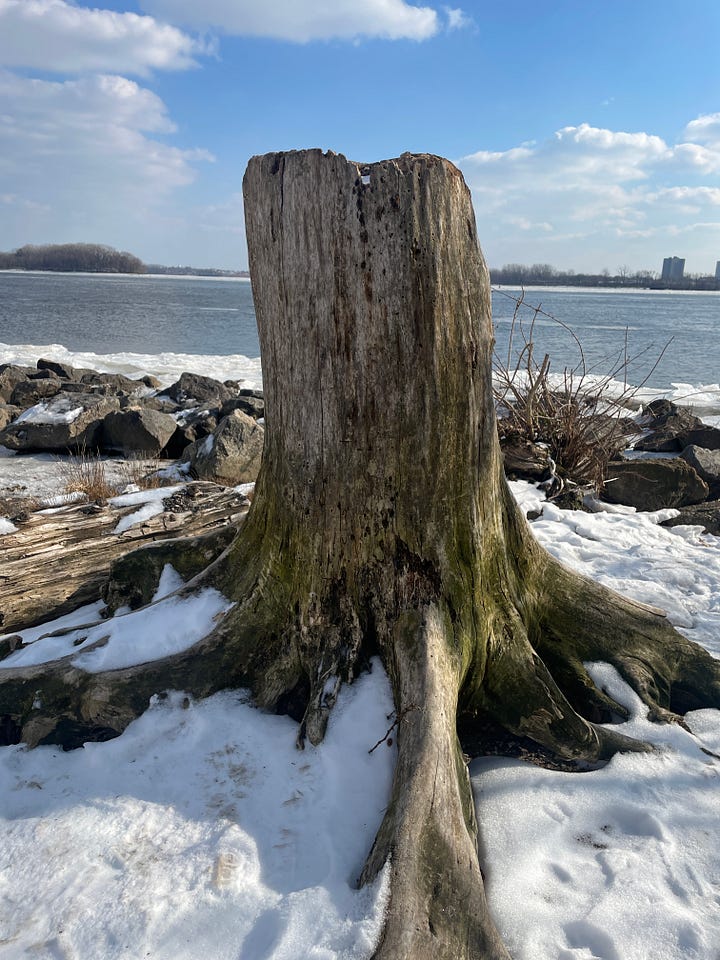
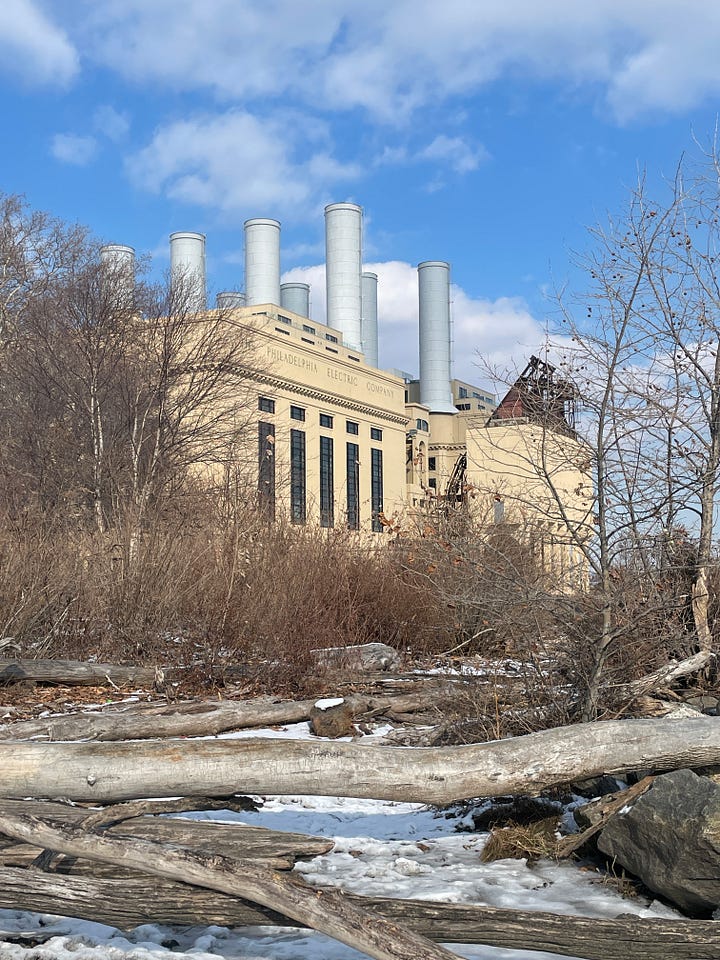
Last weekend, my dear friend G and I were scheduled to have a phone call. He had enlisted my help on a creative project, and the night before, I sent him a few paragraphs of copy. I set out on a walk and put in my earbuds, but when I tried to call, he texted me that he was grumpy and didn’t feel like talking today. I froze in my tracks, standing in the middle of the sidewalk, on my phone, terrified that he was mad at me. This was a totally irrational fear, of course, because why would he possibly be mad at me over a few paragraphs of volunteer marketing copy, even if he hated it? But in the realm of attachment trauma, there’s no distinction between rational and irrational fears. Any amount of loss of connection feels like imminent death, crushing doom.
Did you get my email? I texted anxiously.
Yep! came the reply. I tried to breathe.
Is everything ok? Another bid for reassurance.
All good honey! Just not feeling great today. Let’s talk tomorrow!
That was just enough information for me to wrench my mind out of the clutches of panic, and settle back into my body, though I still felt like I was in trouble; in danger, even.
Panic is a habit, but so is care. I set about a series of tasks, an internal mental dialogue, a practice that’s growing more familiar: ok, breathe. Put away the phone. Look up. Start walking. Notice your feet. Notice your breath. That’s right. Untether yourself from him, what he might be thinking, feeling. I felt myself relax, open. My internal inquiry continued: OK, now, what are you actually feeling? And then: a profound wave of sadness. A rush of hot tears.
Grief. Waves of sweet, dark grief. Oh baby, it’s ok, I cooed to myself, walking, hand on my heart. You’re ok, baby. Shhhhh.
Isn’t it always grief? Under our anger, under our fear: that salt ocean of loss, that pain that tethers us to all other pain, thousands and millions of years of it, grief like the space between the notes, grief like a nail in the heart. Whether separated by death or estrangement—whether I had to walk away because I couldn’t allow myself to continue to be hurt in that way anymore, or they had to, or something else entirely—I miss everyone, every last first best friend. I miss their skin; the way they smell, their laugh, their bodies imprinted on my senses forever. How could they not be? We are animals, first and foremost, ravenous for love, ravenous to live: our bonds and our attachment nothing less than our own survival.
I miss Matt, my best (only) friend my freshman year at the horrible private school I attended for exactly one semester. I remember his nose, the way his eczema flared and his skin reddened and flaked around his nostrils, the thick stubble on his chin, jutted out in a defiant OY—the first and truest punk. I remember the shape of his hands, how his knuckles were gnarled and arthritic, even as a teenager, even before he lived for 20 years in a wheelchair, surviving the shooting, until he didn’t.
I miss Glo, I think every day about all the lessons I missed, all the opportunities I wasted to listen to her and learn from her and show up for her—and I often think about how she would meet this moment, and I think she would meet it with art and healing and creativity and connection and a welcome abundance of incredible food, and I pray that my hands and feet can be hands and feet for her to move through from her place in the ancestor realm.
I miss the ones who have died and I miss the ones who are still among the living: I know that by far, the deepest grief I have known is that of losing my family to estrangement; the pain of choosing my selfhood and dignity over belonging, however necessary and life-giving that choice has been, and I know that every trill of fear in my heart over the possibility of losing a friend echoes and amplifies in the forlorn chamber of my heart where my family should be, but is not.
In naming this grief and placing it in it’s proper context, I claim a spell to put this quarrel to bed, a declaration in front of God and everybody:
I am no longer ranking my friendships or keeping score; I am no longer living in fear. I’m relinquishing control, punishment, fealty; letting go of tricks and treats to make people stay. Real love is everywhere and it shores up the banks of my life against loss and ruin—aways welcome but always unbidden, never on my schedule like a faucet or an outlet or a gum-ball machine, but always in its own time like the rain, like the river, like the moon, like the springtime.
On New Year’s Day we went to a party in Kutztown, at the house of our friends D & R, who we’ve known for thirty years. At our wedding, R stopped us as we crossed the patio towards the reception and played a transcendent song on her violin, and come to think of it, Matt was right there with us, listening too, a gift of beauty that has stayed with me through the decades since.
D & R lived in Boston for a time, and were the only people we knew when we arrived there unannounced in 1999, and they let us sleep on their couch for days (weeks?) while we found a place to live and got jobs. And here I was on New Years Day, sitting on a different couch in a different world with this same dear friend, in a room full of dear friends and their children, noticing how beautiful the tiny lines in her face, how lucky to get to grow old together, how rare and how necessary, knowing that nothing in this life is promised, and nothing guaranteed.
Home.
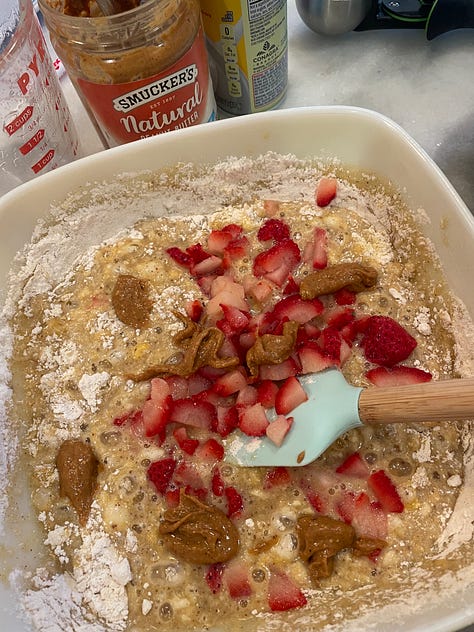
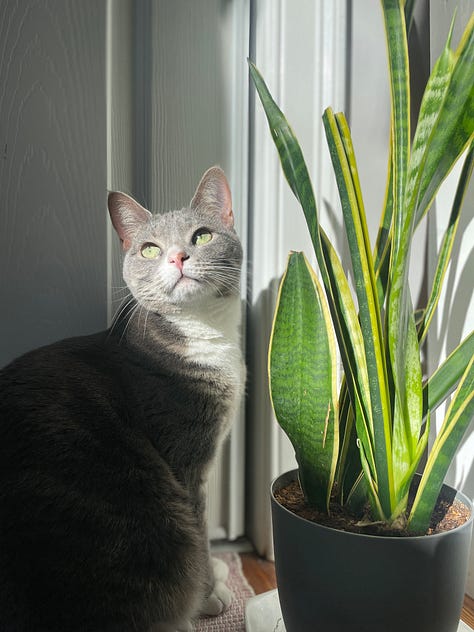

The world.
1) with a list of things we can do when we’re feeling fucked up:
2) Milk Glass Pie’s Mutual Aid Menu.
I really don’t know any cottage/small/independent/craft bakers who have been in the game for any length of time who are not struggling with the wildly contradictory and often untenable demands on their time, bodies, social and family lives, financial well being, and faith in humanity. Whenever a baker tells the truth about the sometimes-grueling reality behind what is also often a beautiful path of autonomy and love-filled creativity, I feel so grateful.
One such truth-teller is my friend, the visionary Aquarian pie queen Keia Mastrianni, proprietress of Milk Glass Pie in Shelby, NC. Keia has been writing about the changes she is making to her business model to make it more sustainable for her human life and her community values, and the path she is forging is always inspiring.
In addition to scaling back production for markets and focusing on special events, collaborations, and writing, Keia has launched a new line of business called the Mutual Aid Menu, where patrons can purchase items “to help us fill our local community fridge, contribute to the next mutual aid event, or support an organization doing essential community work.”
As the polycrisis continues to deepen around and among us, it’s vital that we grow and evolve new (old) ways of relations that are truly mutually beneficial, symbiotic, and life affirming. Every place where you are is a place where you can reach out and lean in to community, and Milk Glass Pie’s mutual aid menu is one inspiring example!
3) Lunar New Year!
Last week ushered in the Year of the Snake, and Philadelphia Chinatown’s Lunar New Year celebrations are jubilant with the victory of community over the proposed Sixers arena’s oligarchs. This week, as planes fall from the sky, the CDC wipes vital public health data from their website, and attacks on our reproductive rights and trans, activist, and immigrant communities escalate (just to name a few of the horrors), I’m surprised to find myself feeling calm and centered in recent days. I think that might be because, over the past two years especially, I have borne witness to the beauty and power of our collective humanity in the face of annihilation, from the sumud of the Palestinian people surviving genocide, to the mutual aid networks spontaneously growing like mycelium in the wake of hurricane Helene in Appalachia. The suffering is real and profound and searingly painful. And yet I’m watching our communities become stronger and more defiant every day.
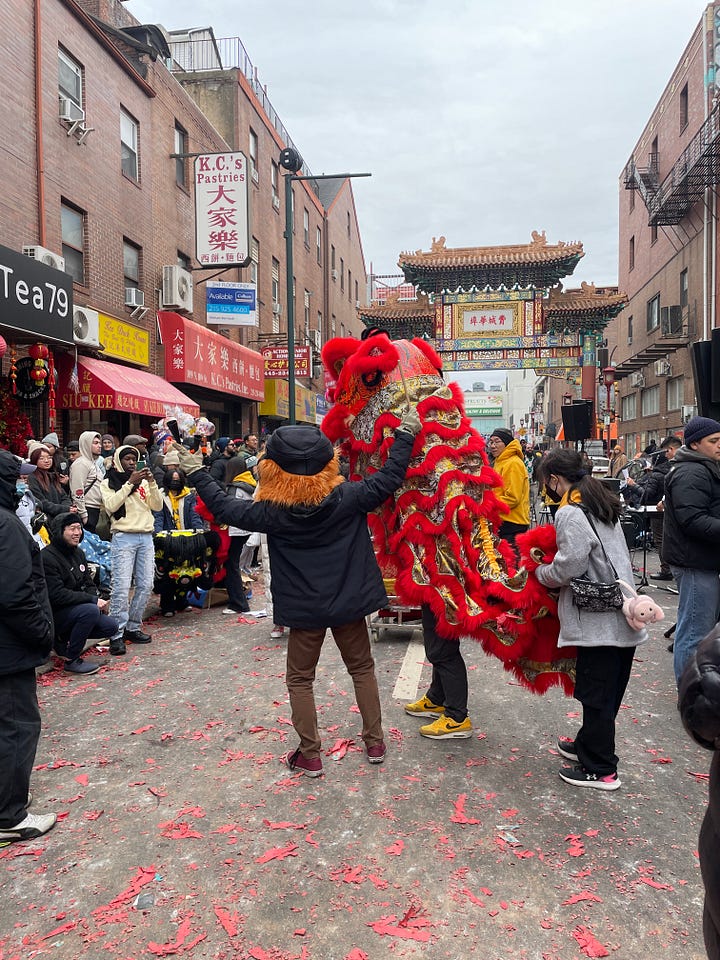
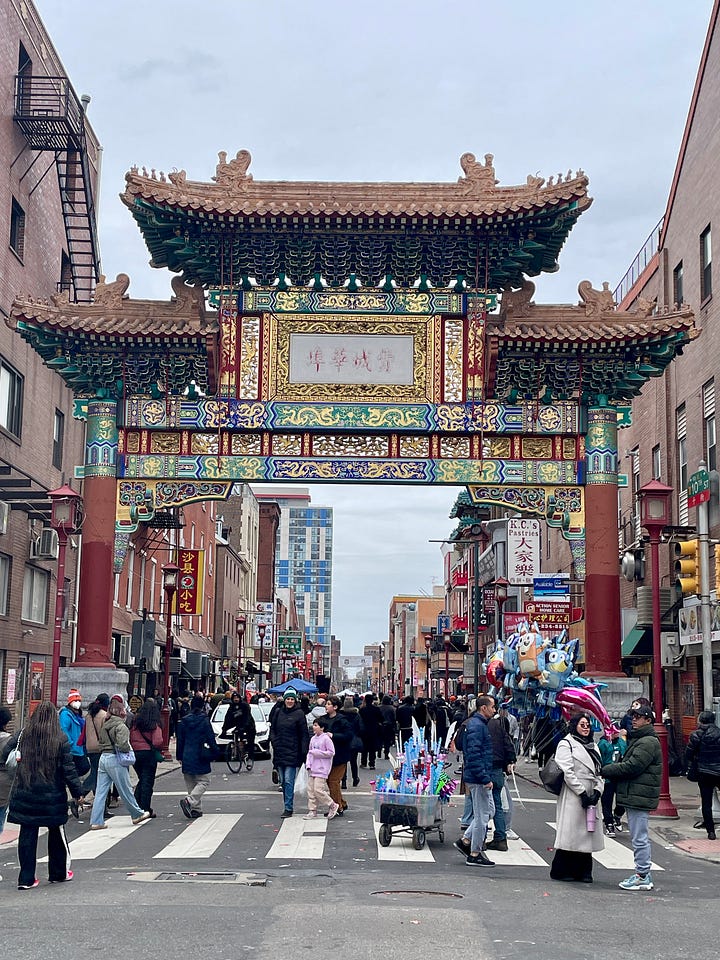
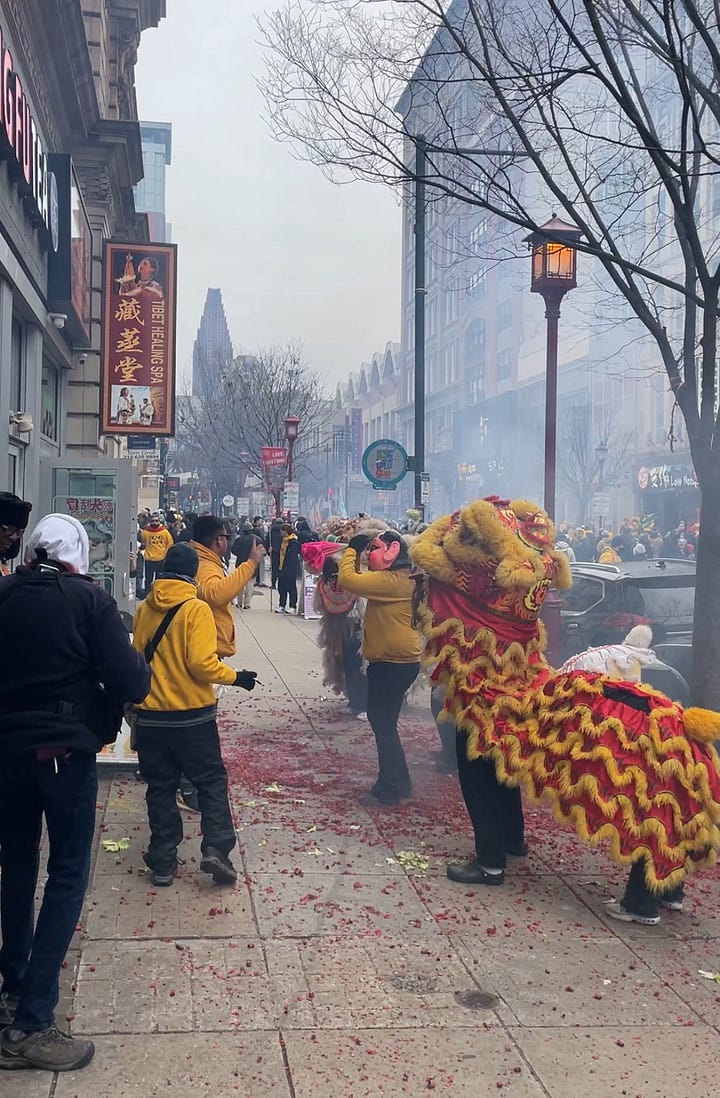
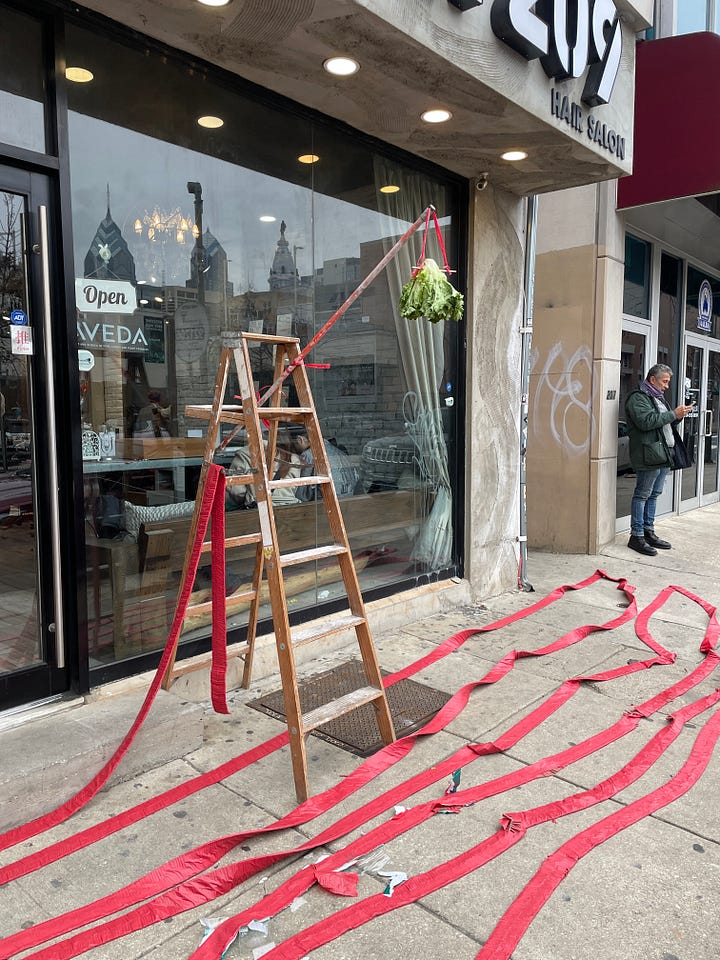
Culture, community, and ritual make us human, and bind us together in our shared struggles. In honor of the Chinatown community’s victory over billionaires, check out this video from Causeway Bay, Hong Kong from November 2024, shortly before the Sixers abandoned their plans to build an arena in Philly’s Chinatown, in the face of a massive popular movement:
Debbie Wei returned to Asia to visit family and explore new places. But she made sure to visit the shamans under the bridge at Causeway Bay in Hong Kong. The shamans there engage in an old ritual called “Da Sifu Yahn” which is literally translated as “beating small people” and sometimes translated as “beating petty people” or “villain beating.” It is an old, and unique ritual designed to ask the gods to provide protection. It is done, in this case, for the protection of Philadelphia Chinatown and to ensure that those who wish harm on the community will not be successful.
May we carry the spirit of Da Sifu Yahn into this new year, into all of our shared struggles, with renewed steadfastness, joyful defiance, and fierce love.
4) The New York War Crimes.
The New York War Crimes is an agitprop/protest/parody newspaper founded by Writers Against the War on Gaza at the start of the escalated Israeli attacks on Gaza in October 2023.2 The latest issue, The Healthcare Edition, was produced in collaboration with Healthcare Workers for Palestine. It is “a tribute to those who stayed: the living, the martyred, and the disappeared. This issue aims to represent the substance of their convictions - from reports and analyses of Zionist terror to testimonies, poems, and songs of resistance, altogether reflecting the role of Gaza's medical workers as a bulwark against death and despair.”
The name New York War Crimes is a nod to a propaganda tool that originated in ACT-UP. At the height of the American AIDS epidemic, members of the ACT-UP adjacent art collective Gran Fury launched a parody publication called the New York Crimes to cover what the Times was ignoring about the crisis. On a broadsheet designed to echo the familiar rag, guerilla reporters spotlit under-acknowledged victims in stories like “Inmates with AIDS: Inadvertent Political Prisoners" and “Women and AIDS: Our Government's Willful Neglect.”
In the lineage of ACT-UP and our radical ancestors, WAWOG and HCW4P are printing thousands of copies to be available in over a dozen locations. Go to the New York War Crimes website to read the issue online, to download the pdf, or click on the "Print Issues" tab to coordinate printing in your city.
Home + The World is an occasional newsletter by Jodi Rhoden featuring personal essay, recipes, links and recommendations exploring the ways we become exiled: through trauma, addiction, oppression, grief, loss, and family estrangement; and the ways we create belonging: through food and cooking, through community care and recovery and harm reduction, through therapy and witchcraft and making art and telling stories and taking pictures and houseplants and unconditional love and nervous system co-regulation and cake.
Home + the World observes the Palestinian Academic and Cultural Boycott of Israel, and Jodi Rhoden is a proud signatory of the Writers Against the War on Gaza statement of solidarity with the people of Palestine.
Visit Home + the World on Bookshop.org, where I’m cataloging my recommended reading in the genres of memoir, fiction, and—of course—healing, self-help, and social justice. If you purchase a book through my shop, I will receive a commission and so will an independent bookstore of your choice. Find it here!
⚔️❤️ Jodi
not her real name.
From Wikipedia: The New York (War) Crimes (NYWC) formed as an ad-hoc collective adjacent to the Writers Against the War on Gaza (WAWOG). In an interview in The Baffler, a collective of editors of The New York (War) Crimes described the beginning of its newspaper as “a piece of agitprop for protest against the New York Times” that became more of a movement outlet. They decided to target The New York Times because of what they see as a longstanding bias in favor of the Israeli military, arguing that “when there’s no way to write a headline that will otherwise exculpate the Israeli army, they’ll just print a headline with no verbs.” The collective chose to target it in particular because they see it as the newspaper of record of the US and the West, and they see its prestige, malfeasance, and complicity as exemplary. According to the collective, The New York Times is “essentially state media, they have the same consent-manufacturing function, but they operate under a conceit of independence, journalistic integrity, and the pursuit of noble truth or whatever.”

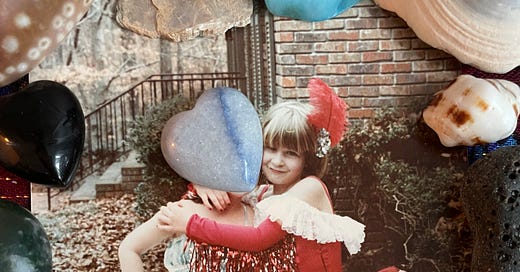



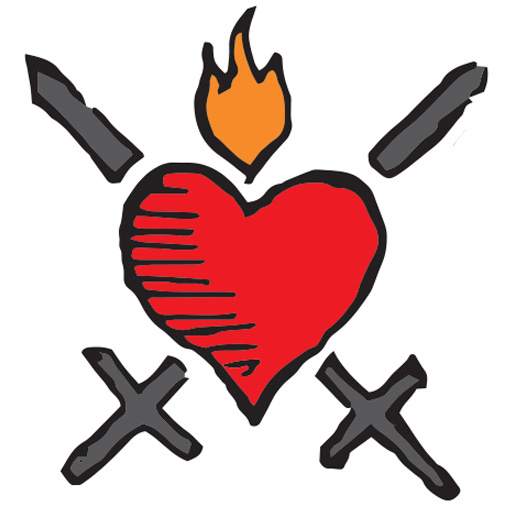



I didn't know what this essay was about until I read it this morning, the day after learning of a death in our food community, after noodling on my own anxious attachment to a friend who has disappeared from my life, after swirling in uncertainty about my business. Thank you for your words and experience. They light my path when it's hard for me to see. xx
Old Friends....yes, sometimes we choose our family. It might just be a bit better that way, yes?